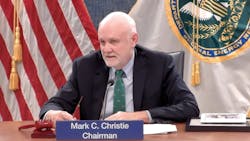FERC to implement new environmental procedures after Supreme Court ruling
The US Federal Energy Regulatory Commission (FERC) will implement its own National Energy Policy Act (NEPA) procedures after a US Supreme Court’s ruling limiting environmental impact evaluations to the physical scope of the project—not the upstream or downstream effects, Chairman Mark Christie told reporters July 24 after his final meeting after President Trump asked him to step down.
The Supreme Court’s ruling in the Seven Country Infrastructure Coalition v. Eagle Country, Colo., is “huge in terms of clarifying” the scope of environmental reviews, an ongoing issue at FERC since before he was on the commission, Christie said.
The former precedent resulted in numerous court cases stalling or overturning gas pipeline and LNG projects and ordering the commission to reevaluate a project’s environmental impacts (OGJ Online, Sept. 19, 2024).
Christie will stay on for 2 weeks to address policies and orders ahead of the commission’s August recess. Trump asked Christie to step down to elevate Laura Swett to lead FERC.
In a press briefing following the meeting, Christie said FERC has no plans to fire employees, although he noted the commission had reorganized to become more efficient and some workers left on a voluntary basis. He said, although it is independent, FERC has generally issued rulings echoing a president’s views. However, he said he hopes that sitting commissioners “always remember the people that aren’t in the room,” referencing the millions of people the agency serves.
At its meeting, FERC authorized Black Bayou Gas Storage to construct and operate a new salt dome natural gas storage project on the Black Bayou salt dome in Cameron Parish, La. The project involves 4 storage caverns with a total working gas capacity of 34.7 bcf; a 44,000 gas-driven reciprocating engine compressor station; two 27.1-mile-long, 24-in. OD bidirectional header pipelines connecting the caverns to interstate pipelines, and 10 meter stations.
The project lies 18 miles north of the Gulf of Mexico coastline and about 25 miles from demand centers in Lake Charles, La., and Port Arthur, Tex., that include 10 LNG terminals and over 30 bcfd of existing and proposed LNG liquefaction capacity.
The commission denied protests and authorized El Paso Natural Gas Co. to construct and operate the Haystack Compressor Station. The project would provide an additional 50,517 dekatherms/day of firm natural gas transportation service to Maricopa County, Az.
FERC also granted Tennessee Gas Pipeline Co. request to abandon, partially in place and partially by removal, a section of its mainline pipeline and pipeline supply lateral in Acadia, Vermilion, Iberia, and St. Mary Parishes in Louisiana.
About the Author
Cathy Landry
Washington Correspondent
Cathy Landry has worked over 20 years as a journalist, including 17 years as an energy reporter with Platts News Service (now S&P Global) in Washington and London.
She has served as a wire-service reporter, general news and sports reporter for local newspapers and a feature writer for association and company publications.
Cathy has deep public policy experience, having worked 15 years in Washington energy circles.
She earned a master’s degree in government from The Johns Hopkins University and studied newspaper journalism and psychology at Syracuse University.
